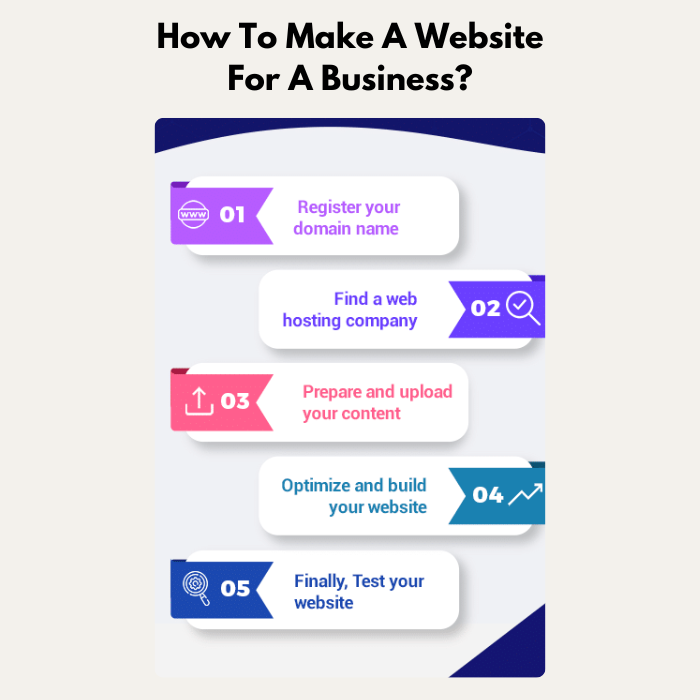How To Make A Website For A Business?
Are you ready to take your business to the next level? In today’s digital age, having a strong online presence is essential for success. And what better way to establish that presence than by creating a website for your business?
Whether you’re a seasoned entrepreneur or just starting out, this blog post will guide you through the process of building an effective and professional website that not only reflects your brand but also attracts potential customers. So grab your laptop and let’s dive into the exciting world of web design.
Businesses large and small must have an online presence in today’s digital world. Not only do consumers expect businesses to have a website, but search engines factor a company’s website into their ranking algorithms. A business without a website is at a competitive disadvantage.
Creating a website for a business is not as difficult or expensive as it once was. There are now many tools and platforms available that make the process of building a website accessible to anyone with basic computer skills. In this article, we will walk you through the steps of how to make a website for your business.
Table of Contents
Benefits of Having a Website for Your Business
There are many benefits of having a website for your business. A website can help you reach a wider audience, connect with customers and clients, and build brand awareness. Having a website can also help you generate leads and sales, and track your progress over time.
A website is a great platform for sharing information about your business, products, and services. You can use your website to showcase your work, post customer testimonials, and provide detailed information about your offerings. A website is also a great way to build relationships with potential and existing customers. You can use your website to answer customer questions, offer support, and stay in touch with your audience.
Having a website can also help you boost your SEO efforts and improve your search engine rankings. By including relevant keywords on your website, you can attract more traffic from people who are searching for what you offer. A well-optimized website can also lead to higher conversion rates, as it will be easier for people to find what they’re looking for when they land on your site.
Having a website is an important part of doing business in the modern world. If you don’t have a website for your business yet, now is the time to get started.
What You Need to Get Started?
If you want to make a website for your business, you will need to have a few things in mind:
- First, you will need to choose a domain name.
- This is the name of your website, and it should be something that is easy to remember and relevant to your business.
- Once you have chosen a domain name, you will need to find a web hosting service.
- This is where your website will be stored and accessed by people on the internet.
There are many different web hosting services available, so you will need to do some research to find one that meets your needs:
Once you have found a web hosting service, you will need to create your website. You can do this yourself using HTML and CSS, or you can use a content management system (CMS) like WordPress or Joomla! If you don’t feel comfortable coding your own website, there are many services that can help you create a professional-looking website without having to learn how to code.
Once your website is created, you will need to promote it. You can do this through search engine optimization (SEO) techniques, social media marketing, and by creating good content that people will want to share.
These are just a few of the things that you need to keep in mind when creating a website for your business. By following these tips, you can create a successful website that will help grow your business.

Choosing the Right Domain Name and Hosting Provider
Your domain name is your website’s address on the internet. It’s how customers will find you online, so it’s important to choose a name that is easy to remember and relevant to your business.
When choosing a domain name, consider these tips:
- Keep it short and sweet
- Use keywords that describe your business
- Make it easy to spell and pronounce
- Avoid using hyphens or numbers
Once you’ve chosen a domain name, you’ll need to find a hosting provider. A hosting provider is a company that will rent out space on their servers for your website. When choosing a hosting provider, look for one that offers:
- Reliable uptime: You don’t want your website going down when customers try to visit it. Look for a provider with at least 99% uptime.
- Affordable pricing: Hosting providers typically charge per month. Look for a provider that fits within your budget.
- Good customer support: If something goes wrong with your website, you’ll want to be able to reach customer support easily. Choose a provider with 24/7 customer support.
Setting Up the Technical Aspects of the Website
Assuming you already have a domain name and hosting account, you will need to connect the two. This is usually done by changing the DNS settings at your registrar to point to your hosting account. Once that is done, your domain name should resolve to your website when entered into a browser.
If you do not have a domain name yet, you will need to purchase one and set it up with your hosting account. Many hosting providers offer free domain names when you sign up for an annual plan.
Once your domain is pointing to your hosting account, you will need to set up your website on the server. This usually involves installing a content management system (CMS) or using a web host’s built-in website builder tool. Once installed, you will be able to log in and start creating content for your site.
If you are not comfortable setting up the technical aspects of your website yourself, most web hosts offer managed WordPress plans that take care of all the behind-the-scenes work for you. These plans typically come at an additional cost but can save you a lot of time and headaches if you’re not comfortable working with server-side technologies.
Designing and Building the Site
Designing and building a website for a business can be a daunting task, but there are some simple steps that can make the process much easier:
First, it’s important to have a clear idea of what kind of website you want to create. Do you want a simple site with just a few pages, or do you need something more complex? Once you know what kind of site you need, you can start planning your design.
Next, you’ll need to choose a web hosting service and register a domain name for your site. Once your site is up and running, you’ll need to add content and promote it online to attract visitors.
With a little planning and effort, you can create a professional-looking website that will help grow your business.
Optimizing It for SEO Purposes
SEO, or search engine optimization, is the process of making your website more visible in search engine results pages.
There are a number of things you can do to optimize your site for SEO, and we’ll go over some of the most important ones here.
- First, make sure your site is well-organized and easy to navigate. This will help search engines index your pages correctly and users will be able to find what they’re looking for more easily.
- Second, use relevant keywords throughout your site. Choose words and phrases that accurately describe your business and the products or services you offer. These keywords should appear in your page titles, headings, and throughout the body of your content.
- Third, create quality content that provides value to your readers. Your content should be informative, keyword-rich, and engaging.
- Fourth, promote your content through social media and other channels. This will help get your content in front of a larger audience and drive traffic back to your site.
- Fifth, track your results with analytics tools so you can gauge the effectiveness of your SEO efforts over time.
By following these tips, you can optimize your website for SEO purposes and improve your visibility in search engine results pages.
Testing and Maintenance
Any website, no matter how simple or complex, needs to be tested and maintained on a regular basis. Testing ensures that all the website’s functionality is working as intended, while maintenance keeps the website up-to-date with the latest security patches and software updates.
There are a few different ways to test a website. The most common is to use an automated testing tool, which will run through a series of tests on the website and report any errors. Another option is to manually test the website yourself, which can be time-consuming but is often necessary to catch all the errors.
Once you’re sure that the website is functioning correctly, it’s important to keep it up-to-date with the latest security patches and software updates. This can be done manually or by using an automated update tool. Either way, it’s important to keep your website’s software up-to-date to protect against any new security risks.
Conclusion
Making a website for your business can seem overwhelming, but with the right tools and guidance, it is possible to create something that will help increase visibility and bring in more customers.
It’s important to remember that you don’t have to be an expert coder or web designer – there are plenty of easy-to-use platforms out there that make creating a professional-looking website simple and stress-free.






